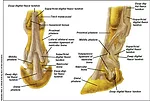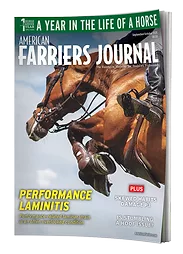Advertise Follow Us
American Farriers Journal

View Archived Issues
July/August 2016
Volume: 42
Edition: 5
American Farriers Journal is the “hands-on” magazine for professional farriers, equine veterinarians and horse care product and service buyers.
-
Table Of Contents
Table Of Contents
Shoeing For A LivingPrinciples Of Footcare Guide Cohesive Team
For farrier Travis Burns and the team at Virginia-Maryland College of Veterinary Medicine, successful outcomes rely on each member contributing to a shared goalRead MoreDiagnosing Issues with the Navicular Apparatus
Farrier and veterinarian Scott Pleasant discusses common causes and ways to recognize navicular diseaseRead MoreGaining A Clearer Picture Of Navicular Problems
The role of medical imaging in treatment and management decisionsRead MoreMaintaining Soundness With The Navicular Horse
Recognize when it’s time to change therapeutic applicationsRead MoreReaping The Benefits Of Hoof Mapping
Colorado farrier says ELPO method provides consistency to identify and address hoof distortionsRead MoreChanging Forces And Tensions
Establish clear goals and understand how altered angles will affect structures before choosing wedgesRead MoreUnderstanding Balance With … a Balloon?
How the foot accepts load is key to symmetry, Maryland farrier saysRead MoreThe World Championship Blacksmiths Hits 10 Years
The Madison, Wis., competition opens the group’s 10th season of “excellence through competition”Read MoreA Step-By-Step Process for Improving Stud Holes
By following these instructions, you can increase the reliability of stud holes for your clients using aluminum shoesRead MoreFarrier Q&A: July/August 2016
Do you offer multi-horse discounts? If not, why not? If yes, how do you structure them?Read MoreUsing Weld Inserts For Corrective Farriery Purposes
If used properly, weld inserts can provide a farrier with an additional tool when therapeutic needs ariseRead MoreHow Do Adhesives Affect Hoof Wall?
Moisture and heat are the most common enemies during repairRead MoreGetting Better Results During the Daily Grind
Improve your efficiency, performance and safety with these tipsRead MoreResearch Journal: July/August 2016
The information, ideas and opinions expressed are those of the author and do not necessarily represent those of the United States Department of Agriculture.Read More -
Featured Articles
Featured Articles
Shoeing For A LivingPrinciples Of Footcare Guide Cohesive Team
For farrier Travis Burns and the team at Virginia-Maryland College of Veterinary Medicine, successful outcomes rely on each member contributing to a shared goalRead MoreGaining A Clearer Picture Of Navicular Problems
The role of medical imaging in treatment and management decisionsRead MoreChanging Forces And Tensions
Establish clear goals and understand how altered angles will affect structures before choosing wedgesRead More - Digital Edition
-
Online Extras
Online Extras

















